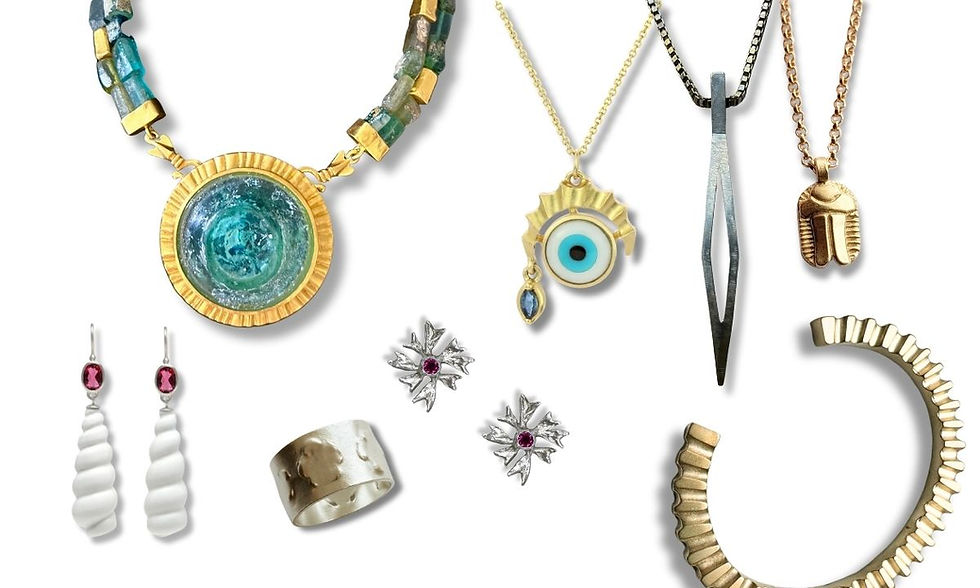April is for Diamonds - The Diamond Guide
- Elise Thompson

- Apr 26, 2021
- 4 min read
Updated: Apr 27, 2021
April babies can celebrate their special day with one of the most scintillating gemstones of them all, DIAMOND. This is the diamond guide you've been waiting for to help you navigate through Space 85's handcrafted designer diamond jewelry.

Sparkly Carbon
The allure of a diamond is in its sparkle, size, and color. Who doesn’t love to gaze into a diamond in the sunlight and watch it shine brilliantly while a rainbow of colors called "fire" bounces out of its magical matter. This matter is carbon. Diamond is the only mineral made of a single element, carbon.
What makes a diamond precious is that it is beautiful, it is rare, and it is durable. Diamonds form under extreme heat and pressure and endure a rough journey from the center of the earth, starting as a piece of black carbon and travel to the earth’s surface. Intense heat and pressure push the carbon through the earth’s crust into ocean’s, lakes, rivers, and mountains. Diamonds form under these natural circumstances and into rough crystallized matter.

The crystals are then cut, if they are gem material, into the diamonds you see used in our precious jewels. Other diamond material that is not gem quality can be used as diamond dust or other types of industrial uses.
DID YOU KNOW ONLY A DIAMOND CAN CUT A DIAMOND?
Since only diamond is strong enough to cut through its own type, industrial grade diamond is ground into dust and used on cutting wheels to fashion a gem grade diamond.
The 4 C’s - CLARITY, COLOR, CUT, CARAT WEIGHT
CLARITY and COLOR
The types of diamonds we celebrate at Space 85 range from traditional colorless brilliant diamonds, to colored diamonds like yellow, grey, brown, black, and champagne. The diamond grading system created by GIA ranges from colorless to dark yellow on a scale of D-Z. The "whitest" and without color earns a D while the darkest yellow earns a Z. Don't confuse Z color with "fancy yellow" diamonds which are graded on a separate fancy scale.
GIA created a scale to grade clarity as well ranging from F to I. The most rare diamonds earn an F in clarity for "flawless" inferring there are no internal inclusions in the diamond. Most colorless diamonds used on Space 85 are VS or S, "very slightly" or "slightly included", unless specified otherwise. Some bear the “birthmarks” of their intense journey through the earth’s surface. These “birthmarks” are inclusions and give a precious gem its one-of-a-kind beauty, just like our human birthmarks give us our unique beauty. At Space 85 our designers celebrate a diamonds color and inclusions through thoughtful jewelry design.
DIAMONDS have internal features called inclusions and surface characteristics. Over time, peoples interpretation of what types of diamonds are suitable for jewelry have changed. From only using traditionally cut colorless diamonds that don’t exhibit blatant inclusions in jewelry in the past, we now accept rough diamonds, opaque diamonds, black, brown, grey, and fancy cut diamonds that celebrate inclusions and blemishes.
DID YOU KNOW diamonds come in many colors? Some of the most rare colors are red, purple, and green. With colored diamonds, the more color the more valuable.
Space 85 offers diamond jewelry with varying clarities and colors ready to suit your personal taste and budget.
CUT and CARAT WEIGHT
As with clarity and color, consumers have come to accept less traditional cuts in diamonds as well. Designer handmade jewelry can use rough, rose cuts, and traditional cut diamonds in their work.
Rough gemstones are set as they are found in nature, without any lapidary work at all.
Taryn Leavitt uses rough diamonds and diamond slices in these one-of-a-kind 18k gold gemstone earrings.
Rose cut gemstones have facets usually in a diamond shape, covering the entire surface face up.
Linda Hoj uses rose cut diamonds in colors ranging from light grey to black. These earrings called Eryie Gate are hand fabricated in 22k gold with round light grey rose cut diamonds.
Traditional standard round brilliant diamonds have 33 facets above the girdle and 24 o4 25 below the girdle.
Ruth Edelson uses round brilliant diamonds as the center for her 18k rose gold rose blossom stud earrings.
A brilliant cut is used as a term to describe a gemstone in any shape with facets that are mostly triangular or kite shaped and radiate from the center like the round brilliant cut. Cuts in other shapes are called fancy cuts such as marquise, pear, oval, heart shape, emerald cut, or princess cut.

Three important diamond attributes are brilliance, fire, and scintillation. Brilliance is the brightness created by all the white light reflections from the surface and the inside of a polished diamond. Fire is the flashes of color you see, and scintillation are the flashes of light you see when the diamond, the light, or the observer move. The quality of the cut has a direct relationship to how much brilliance, fire, or scintillation a diamond exhibits.
CARAT with a “C”
Diamonds and other gemstones are weighed in carats. The most important aspect to understand with carats is that a larger diamond is worth more than a smaller diamond because larger diamonds are more rare. Gemstones are priced “per carat” and the carat price generally increases as the gemstone weight increases.
We hope you enjoyed this short tutorial on diamonds. Leave a comment and let us know!

























Comments